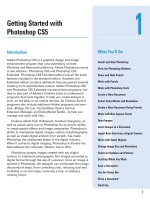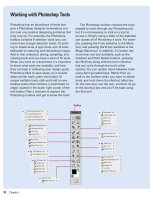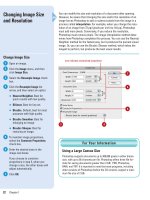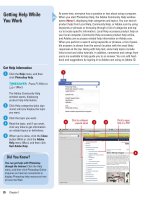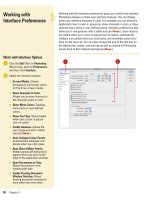Photoshop cs5 by steve Johnson part 37 ppsx
Bạn đang xem bản rút gọn của tài liệu. Xem và tải ngay bản đầy đủ của tài liệu tại đây (688.79 KB, 6 trang )
ptg
232 Chapter 9
Having the ability to draw a perfect polygon or rounded-corner rectan-
gle is nice; however, Photoshop went way beyond standard shapes
when it introduced the Custom Shape tool. Photoshop now comes
packaged with dozens of predesigned shapes, or you can even create
your own. User-defined shapes can be made from literally any vector
object. For example, a company logo can be converted to a custom
shape. Custom shapes have many time-saving applications. As previ-
ously mentioned, a company logo, if used frequently, is only a mouse
click away. Any vector form, outline, or shape used on a recurring
basis, can be converted to a custom shape and saved for future use.
Select the Custom Shape tool or, if you have any shape drawing tool
selected, click the Custom Shape button from the Options bar, and then
configure the shape using choices from the Options bar.
Working with the
Custom Shape Tool
Work with the Custom
Shape Tool
Select the Custom Shape tool on
the toolbox.
Click the Fill Pixels button to
create raster shapes, using the
active foreground color.
Click the Geometry options list
arrow, and then select from the
available options: Unconstrained,
Defined Proportions, Defined Size,
Fixed Size, or From Center.
Click the Shape list arrow, and
then select a shape from the
available options.
Click the Mode list arrow, and then
select a blending mode.
Enter an Opacity percentage value
(1% to 100%).
Select the Anti-alias check box to
create a visually smoother line.
Drag in the document window to
create the customized shape.
8
7
6
5
4
3
2
1
1
3
2
4
6
5
8
7
From the Library of Wow! eBook
ptg
Chapter 9 Using the Paint, Shape Drawing, and Eraser Tools 233
Custom shapes can be created from anything you choose, and the
process is quick and simple. You just create the shape, select the
shape, and name the shape. That's it. Since shapes are vector images,
they're resolution-independent, which means you can draw them at
any size without impacting image quality. Once custom shapes are
saved, they can be accessed by opening a document, selecting the
Shape tool, and choosing your new shape from the Custom Shapes
panel.
Creating a Custom
Shape
Create a Custom Shape
Open a document that contains
the vector image you want to
convert into a shape, or create a
shape using any of Photoshop's
vector drawing tools.
Click the Edit menu, and then click
Define Custom Shape.
Enter a name for the new shape.
Click OK.
The shape appears as a thumbnail
at the bottom of the active Custom
Shapes panel.
4
3
2
1
3
4
1
Shape designed
in a Shape layer
Did You Know?
You can move Photoshop shapes into
other vector programs, such as
Illustrator, FreeHand, and even Flash.
Click the File menu, point to Export, and
then click Paths To Illustrator. Name
the new document, and then click
Save.
From the Library of Wow! eBook
ptg
234 Chapter 9
Creating customized sets of shapes is an excellent way to get organ-
ized. The next time you need a specific shape all you have to do is
select the shape from your organized sets. Organization can save you
time, but it also lends a sense of consistency to designs. Using the
same customized shapes repeatedly helps to tie the elements of a
design together, and Photoshop gives you the perfect way to maintain
that consistency with customized shape sets.
Saving Custom
Shape Sets
Save Custom Shape Sets
Select the Custom Shape tool on
the toolbox.
Click the Shape list arrow to see a
list of the current shapes.
Create new shapes, and then add
them to the current list.
IMPORTANT
As you create
new shapes, if there are some you
don’t like, delete them. Right-click
the shape, and then click Delete
Shape.
To add preexi st in g shapes, click
the Options button, and then click
Load Shapes, or choose from the
available predefined shape lists.
Click the Options button, and then
click Save Shapes.
Enter a descriptive name for the
new set in the File Name (Win) or
the Save As (Mac) box.
Click the Save In (Win) list arrow
or Where (Mac) popup, and then
select a location to save the new
set.
IMPORTANT
If you save the
new set in the Custom Shapes
folder, located in the Adobe
Photoshop CS5 application folder,
the new set will appear as a
predefined set when you click the
Shapes Options button.
Click Save.
8
7
6
5
4
3
2
1
1
2
5
8
7
6
From the Library of Wow! eBook
ptg
Chapter 9 Using the Paint, Shape Drawing, and Eraser Tools 235
The Paint Bucket tool is not new; in fact, it's been around almost as
long as Photoshop. The Paint Bucket's primary function is to fill an area
with the active foreground color, but that's not all it's capable of doing.
The Paint Bucket tool can fill areas with a selected pattern and, much
the same way that the Magic Wand tool selects image information, the
fill area can be controlled by the shift in brightness of image pixels.
Combine those features with the ability to change the Paint Bucket's
blending mode or opacity, and you have a tool with a lot of horsepower.
Using the Paint
Bucket Tool
Use the Paint Bucket Tool
Select the Paint Bucket tool on the
toolbox.
Click the Fill list arrow, and then
select an option:
◆ Foreground. Fills a selected
area with the current
foreground color.
◆ Pattern. Fills a selected area
with a pattern.
Click the Pattern list arrow, and
then select a predefined fill
pattern. This option is available if
you select Pattern as a fill option.
Click the Mode list arrow, and then
select a blending mode.
Enter an Opacity percentage value
(1% to 100%).
Select a Tolerance value (0 to 255).
The Tolerance value influences the
range that the Paint Bucket uses
to fill a given area.
Select the Anti-alias check box to
create a visually smoother line.
Select the Contiguous check box
to restrict the fill to the selected
area.
Select the All Layers check box to
fill the color range information
from all the image’s layers.
Click the Paint Bucket tool cursor
on the area to be changed.
10
9
8
7
6
5
4
3
2
1
1
4
2
5
6
3
7 8
9
10
From the Library of Wow! eBook
ptg
236 Chapter 9
Photoshop's basic Eraser tool converts image pixels in a layer to trans-
parent pixels. While the primary function of the Eraser tool has not
changed, the tool itself has been greatly improved. For example, you
can use the Eraser tool to remove a specific color or to erase around
the edge of an object. You can instruct the Eraser tool to remove a spe-
cific color while protecting another color and at the same time,
increase or decrease the tool's tolerance (the range of selection). If
you use the Eraser tool on a layered document, the tool will erase to
transparency. If the Eraser tool is used on a flattened document (flat-
tened documents do not support transparency), the Eraser tool will use
the active background color to perform the erasure. As you can see,
the eraser tools do more than blindly erase image information. As you
master the eraser tools, you just may find those complicated eraser
jobs becoming easier and easier. The Background Eraser tool lets you
select specific colors within an image and erase just those colors.
Working with the
Eraser Tools
Use the Basic Eraser Tool
Select the Eraser tool on the
toolbox.
Click the Brush list arrow, and then
select a brush tip.
Click the Mode list arrow, and then
select a blending mode.
Enter an Opacity percentage value
(1% to 100%) to determine how
much the eraser removes from the
image.
Enter a Flow percentage value
(1% to 100%) to determine the
length of the eraser stroke.
Click the Airbrush button to
change the solid eraser stroke of
the eraser to that of an airbrush.
Select the Erase To History check
box to temporarily turn the Eraser
into a History Brush.
Drag the Eraser over an image
layer to convert the image pixels
to transparency.
8
7
6
5
4
3
2
1
1
3
2
4
5
6
8
7
From the Library of Wow! eBook
ptg
Chapter 9 Using the Paint, Shape Drawing, and Eraser Tools 237
Use the Background Eraser Tool
Select the Background Eraser tool
on the toolbox.
Click the Brush list arrow, and then
select a brush tip.
Click one of the Sampling buttons
(determines how the Background
Eraser selects the color range):
◆ Continuous. Continually selects
a color range as you drag the
Eraser tool across the image.
◆ Once. Samples a color range
when you first click your
mouse.
◆ Background Swatch. Only
erases the active background
color.
Click the Limits list arrow, and
then click how far you want the
erasing to spread:
◆ Discontiguous. Lets the Eraser
tool work with all similar color
range pixels throughout the
image.
◆ Contiguous. Restricts the
Eraser tool to the selected
color range, without moving
outside the originally sampled
area.
◆ Find Edges. Looks for a shift in
color range and attempts to
erase to the visual edge of the
image.
Select a Tolerance percentage
value (1% to 100%). The higher the
tolerance, the greater the range.
Select the Protect Foreground
Color check box to prevent that
color from being erased.
Drag in the image to erase.
7
6
5
4
3
2
1
1
3
2
4
5
6
7
Using the Background Eraser Tool
The Background Eraser tool erases an image by converting the
image pixels to transparency. If you attempt to use the Background
Eraser tool on a flattened image, the tool will automatically convert
the flattened background into a normal layer. Photoshop is actually
making an assumption that if you're using the Background Eraser
tool, you obviously need the image to be on a layer that supports
transparency, not a background layer.
For Your Information
From the Library of Wow! eBook
